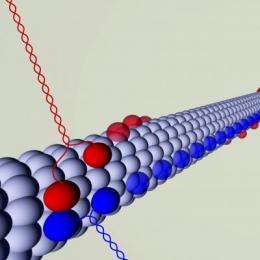Mini cargo transporters on a rat run: New insight on molecular motor movement

Kinesins assume a vital function in our cells: The tiny cargo transporters move important substances along lengthy protein fibers and ensure an effective transportation infrastructure. Biophysicists of the Technische Universitaet Muenchen and the Ludwig Maximillians Universitaet Muenchen have now discovered how some of these transporters can, like cars on a multi-lane motorway, change lanes. The researchers report on this hitherto unknown phenomenon in the current edition of the renowned journal Molecular Cell.
Molecular motors are the key to the development of higher forms of life. They transport proteins, signal molecules and even entire chromosomes down long protein fibers, components of the so-called cytoskeleton, from one location in the cell to another. Not unlike trucks on a motorway, there are permanently thousands of these small motor proteins underway at any given point in time – a highly coordinated and extremely fast mode of transport. This highly efficient infrastructure is a prerequisite for the formation of large, complex cells and multicellular organisms. Bacteria, for example, lack this foundation, because they possess neither molecular motors nor cytoskeletons.
Kinesins represent one class of such molecular motors. They run along microtubules comprising 13 individual fibers arranged in a tube form. Kinesins are made up of a twisted pair of protein chains. Each chain comprises a head that can dock to the surface of the microtubules and a neck domain, as well as a stalk and tail domain that the cargo is attached to. Kinesins move forward by placing one head in front of the other in alternation which resembles human walking. The first mechanistically scrutinized kinesin was Kinesin-1, which performs numerous steps in succession without detaching from the microtubule. In the process it moves ahead in a perfectly straight path on its long journey, always remaining on a single fiber of the microtubule.
Scientists led by Zeynep Oekten, group leader at the Biophysics Department of the Technische Universitaet Muenchen, and Melanie Brunnbauer, a doctoral candidate at the Biophysics Department, have now for the first time demonstrated that kinesins also "switch lanes" during transport. The scientists identified the region in the kinesin protein that determines whether a given kinesin type moves on a straight path or in a spiral fashion. It is a structural element in the neck domain. "If the neck region is stable, the two kinesin heads have only limited reach. The kinesin cannot make any sidesteps and thus moves straight ahead," says Oekten. "However, if the responsible area becomes destabilized, the reach of the heads is increased and the motor protein can jump fibers and spiral around the microtubule."
To confirm this new insight, the scientists integrated specific amino acids into the responsible areas – a kind of molecular switch that allowed them to regulate the reach of the two heads. The result left no doubt: Destabilizing the neck region of the Kinesin-1 motor increases the reach of the two heads, which in turn causes the Kinesin-1 to depart from its normally perfectly straight path and move along a spiral-shaped path. When they mimicked a stable neck region using a chemical crosslinker, they coerced the protein into running straight again.
Oekten and Brunnbauer arrived at their new insight using a unique experimental setup. They placed two 3-micron large synthetic beads in a solution and trapped each using a laser beam, a so-called pair of "optical tweezers." Then, in precision work, they placed a piece microtubule between the beads. In a final step, again using a laser beam, they trapped a third bead coated with a specific type of kinesin and carefully placed it onto the microtubule.
As soon as they deactivated the third laser beam, the motor protein started marching forward and the scientist could follow the path of the molecule under the microscope. "In this way we were able, for the first time ever, to directly observe the spiraling movement of a motor type," explains Oekten. "When we saw the teetering movement of a Kinesin-2 protein for the first time, we all laughed. The motion was so clear and obvious, you just had to look at it and all doubt vanished." The experimental setup allows the molecular motors to move freely, thereby emulating real-life conditions in the cell much better than previous methods of investigation.
Using their new experimental setup, Oekten and Brunnbauer investigated a whole series of different Kinesin-2 proteins from various organisms – with an unexpected result: Contrary to the hitherto prevalent assumption that kinesins typically move only on straight paths, almost all kinesins displayed some form of spiral movement, in manifold variations. "This shows us that spiral motion is not an exception in nature, but rather the rule," explains Oekten. "In fact, the more relevant question is why evolution has brought about the straight-line movement as we observe with the Kinesin-1. That is truly unusual considering the nano-scale precision it requires to confine a kinesin transporter on an exclusively straight path." The researchers Oekten and Brunnenbauer hope to more closely investigate the reasons for the various kinds of motion in the future.
Provided by Technical University Munich


















